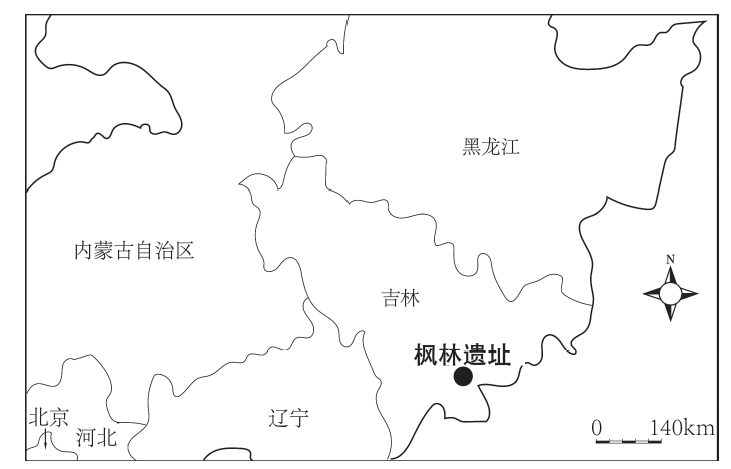

A study of microblade cores from the Fenglin Paleolithic site in Jilin Province, Northeast China
Received date: 2017-03-13
Revised date: 2017-06-20
Online published: 2020-09-15
The Fenglin site is a Late Paleolithic open air site, located in the southeast of Jilin Province, China. This site has been systematically investigated and excavated in 2016 by a joint team from the Jilin Provincial Institute of Cultural Relics and Archaeology, the Institute of Vertebrate Paleontology and Paleoanthropology under Chinese Academy of Sciences, and the Fusong Cultural Relics Management Office. A large number of lithic artifacts has been unearthed. These include blades, microblades, microblade cores, scrapers, flakes, etc. Obsidian dominates the raw materials. Two types of wedged-shaped microblade cores were recognized, and each type shows different stages of core reduction. Microblade technology was widespread in Northeast Asia during the Late Paleolithic, and the production and utilization of microblade tools obviously made a noticeable impact on hunter-gatherers’ migrations and adaptations in the region. Analysis of lithic typology and technology from sites like Fenglin can contribute to a better understanding of human prehistory in Northeast Asia, addressing major shifts in subsistence strategies, settlement patterns and other aspects of social life.

Key words: Fenglin site; Fusong County; Late Paleolithic; Microblade cores
Chuan TIAN , Ting XU , Ying GUAN , Xing GAO . A study of microblade cores from the Fenglin Paleolithic site in Jilin Province, Northeast China[J]. Acta Anthropologica Sinica, 2019 , 38(01) : 19 -32 . DOI: 10.16359/j.cnki.cn11-1963/q.2017.0063
| [1] | Barton LW, Brantingham PJ, Ji DX. Late Pleistocene climate change and Paleolithic cultural evolution in northern China:Implications from the Last Glacial Maximum[J]. Developments in Quaternary Science, 2007(9):105-128 |
| [2] | Elston RG, Brantingham PJ. Microlithic Technology in Northern Asia: A Risk-Minimizing Strategy of the Late Paleolithic and Early Holocene[M]. Archeological Papers of the American Anthropological Association, January 2002,12(1):103-116 |
| [3] | 安志敏. 中国细石器发现一百年[J].考古, 2000(5):45-56 |
| [4] | 贾兰坡, 盖培, 尤玉柱. 山西峙峪旧石器时代遗址发掘报告[J]. 考古学报, 1973(1):39-58 |
| [5] | 陈胜前. 细石叶工艺的起源——一个理论与生态的视角[A].见: 北京大学考古文博学院编:考古学研究(七)[C].北京:文物出版社, 2008: 244-264 |
| [6] | 陈全家, 张乐. 吉林延边珲春北山发现的旧石器[J]. 人类学学报, 2004,23(2):138-145 |
| [7] | 陈全家, 赵海龙, 霍东峰. 和龙市柳洞旧石器地点发现的石制品研究[J]. 华夏考古, 2005(3):51-59 |
| [8] | 陈全家, 赵海龙, 王春雪. 抚松新屯西山旧石器古营地遗址试掘报告[J]. 人类学学报, 2009(2):147-153 |
| [9] | 王春雪, 陈全家. 试析吉林和龙石人沟旧石器时代晚期遗址古人类的技术与行为[C].边疆考古研究(第6辑), 2007: 39-55 |
| [10] | 陈淳. 中国细石核类型和工艺初探——兼谈与东北亚、西北美的文化联系[J]. 人类学学报, 1983,2(4):331-341 |
| [11] | 仪明洁, 裴树文, 陈福友, 等. 水洞沟第12地点楔形石核的“操作链”分析[C]. 边疆考古研究(第18辑), 2015: 105-119 |
| [12] | 梅慧杰. 楔形石核系统分类的相关认识[A].见: 北京大学考古文博学院编:考古学研究(七)[C].北京:文物出版社, 2006: 265-271 |
| [13] | Leroi-Gourhaen A. Le geste et la parole Ⅱ—La Mémoire et les Rythmes[M]. Revue fran?aise de sociologie, 1965 |
| [14] | Schiffer MB. Archaeology as Behavioral Science[J]. American Anthropologist, 1975,77(4):836-848 |
| [15] | William Andrefsky Jr. Raw-Material Availability and the Organization of Technology[J]. American Antiquity, 1994: 21-34 |
| [16] | Michael J. Shott,CHA?NE OPéRATOIRE and Reduction Sequence[M]. Lithic Technology, 2003: 95-105 |
| [17] | 盖培. 阳原石核的动态类型学研究及其工艺思想分析[J]. 人类学学报, 1984,3(3):244-252 |
| [18] | 朱之勇, 高星. 虎头梁遗址楔形细石核研究[J]. 人类学学报, 2006,25(2):129-142 |
| [19] | 王建, 王益人. 下川细石核形制研究[J]. 人类学学报, 1991,10(1):1-11 |
| [20] | 林景胤, 董佩信. 长白山黑曜岩地质特征与成因浅析[J]. 地质与资源, 2016(4):204-207 |
| [21] | 王春雪, 陈全家. 试析吉林和龙石人沟旧石器时代晚期遗址古人类的技术与行为[C].边疆考古研究(第6辑), 2007: 39-55 |
| [22] | 李霞. 和龙崇善大洞旧石器遗址2007年发掘的石器研究[D]. 吉林大学硕士学位论文, 2008, 1-56 |
| [23] | 陈全家, 赵海龙, 王春雪. 抚松新屯西山旧石器古营地遗址试掘报告[J]. 人类学学报, 2009,28(2):147-153 |
| [24] | 陈全家, 赵海龙, 方启, 等. 延边和龙石人沟旧石器遗址2005年试掘报告[J]. 人类学学报, 2010,26(2):105-114 |
| [25] | Chuntaek Seong. Microblade Technology in Korea and Adjacent Northeast Asia[J]. Asian Perspectives: The Journal of Archaeology for Asia and the Pacific, 1998,37(2):45-278 |
| [26] | Buvit Ian, Karisa Terry. The twilight of Paleolithic Siberia: Humans and their Environments east of Lake Baikal at the Late-glacial/Holocene Transition[J]. Quaternary International, 2011,242(2):379-400 |
/
| 〈 |
|
〉 |